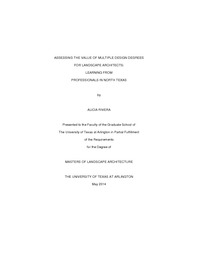
ATTENTION: The works hosted here are being migrated to a new repository that will consolidate resources, improve discoverability, and better show UTA's research impact on the global community. We will update authors as the migration progresses. Please see MavMatrix for more information.
Show simple item record
| dc.contributor.author | Rivera, Alicia | en_US |
| dc.date.accessioned | 2014-07-14T20:30:13Z | |
| dc.date.available | 2014-07-14T20:30:13Z | |
| dc.date.issued | 2014-07-14 | |
| dc.date.submitted | January 2014 | en_US |
| dc.identifier.other | DISS-12691 | en_US |
| dc.identifier.uri | http://hdl.handle.net/10106/24475 | |
| dc.description.abstract | Many of the early professionals in the landscape architecture profession had other previous design education (Tishler, 1989). For example, Hideo Sasaki and Lawrence Halprin had exposure to other academic fields, like environmental design and architecture (Mann, 2009). According to ASLA: 2013 Survey of Graduating Students data nearly one tenth of the landscape architecture graduate degree recipients had a previous degree in landscape architecture and about one fifth of them had a previous degree in another design or planning field (ASLA, 2013). It seems like acquiring another design and or planning degree before coming to landscape architecture is common among landscape architects. Yet very little is known about how much the exposure to multiple design degrees affects these landscape architecture professionals during their education and in their professional practice.
The purpose of this study is to assess the value of a multiple design degree background among landscape architecture professionals, particularly the ones practicing in North Texas. The research specifically concentrated on the review of educational background and experience, as well as the details of the daily professional practice of the individuals who have degrees in architecture and or other relevant design fields in addition to landscape architecture. A few of the topics covered by this research are the similarities and differences among the degrees received, participants’ comparison with colleagues of a single design degree, what value each degree brings to their daily professional practice, and the recommendations for future landscape architecture education, research, and practice.
The research follows qualitative methods to study the implications of a multiple design degree background among landscape architecture professionals. Open-ended interviews, using snowball technique to recruit participants, are conducted with North Texas professionals with multiple design degrees (Taylor and Bogdan, 1998). The data are later transcribed, coded, and organized into a database. The constant comparative method from the grounded theory was applied in the analysis and themes were derived (Glaser and Strauss, 1967).
In conclusion, not surprisingly, a majority of the participants felt positive about their background and its impacts on their professional practice. The common theme among the participants was how the multiple design degrees assisted them with easier communication skills among other professions when multi-disciplinary collaboration was needed in a project. Also, many of the participants' current position reflected their skills obtained in both design educations. Results also illustrated that they would have had minimal additional exposure to other fields, if they had only single design degree, suggesting that students would benefit from earlier exposure to other design fields in their education for greater dialogue and engagement with allied design fields. | en_US |
| dc.description.sponsorship | Ozdil, Taner R. | en_US |
| dc.language.iso | en | en_US |
| dc.publisher | Landscape Architecture | en_US |
| dc.title | Assessing The Value Of Multiple Design Degrees For Landscape Architects: Learning From Professionals In North Texas | en_US |
| dc.type | M.L.A. | en_US |
| dc.contributor.committeeChair | Ozdil, Taner R. | en_US |
| dc.degree.department | Landscape Architecture | en_US |
| dc.degree.discipline | Landscape Architecture | en_US |
| dc.degree.grantor | University of Texas at Arlington | en_US |
| dc.degree.level | masters | en_US |
| dc.degree.name | M.L.A. | en_US |
Files in this item
- Name:
- Rivera_uta_2502M_12691.pdf
- Size:
- 3.487Mb
- Format:
- PDF
This item appears in the following Collection(s)
Show simple item record


